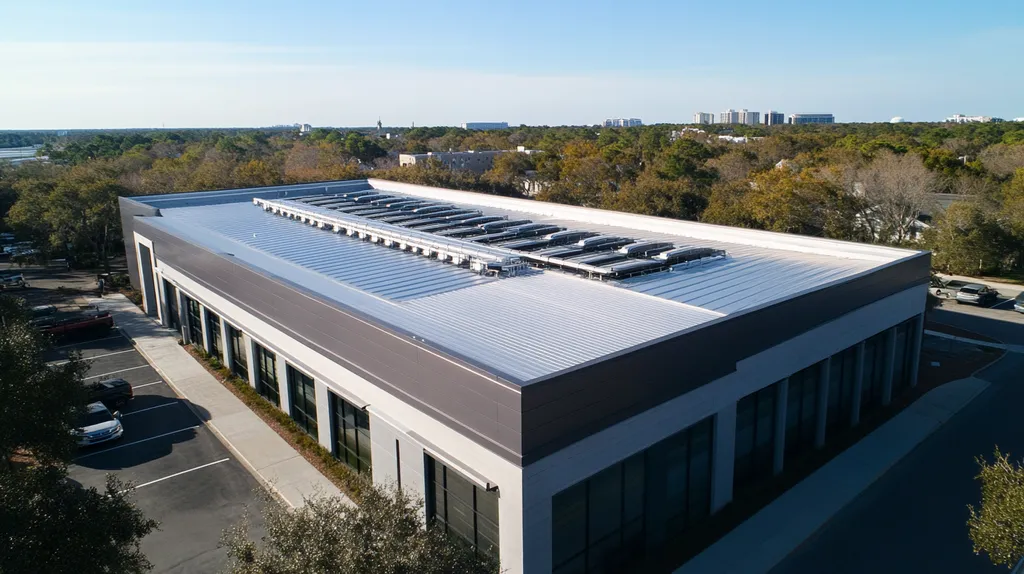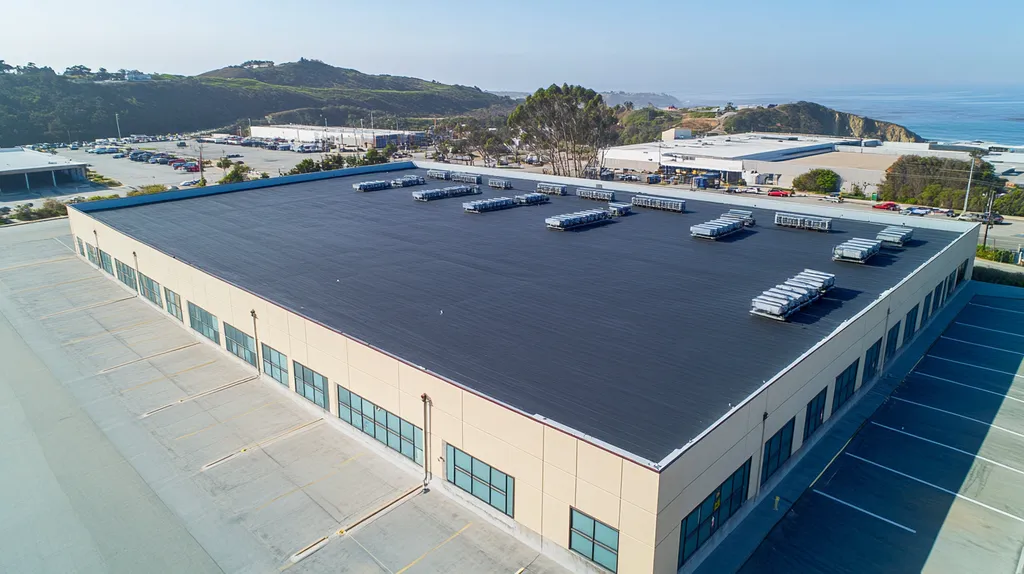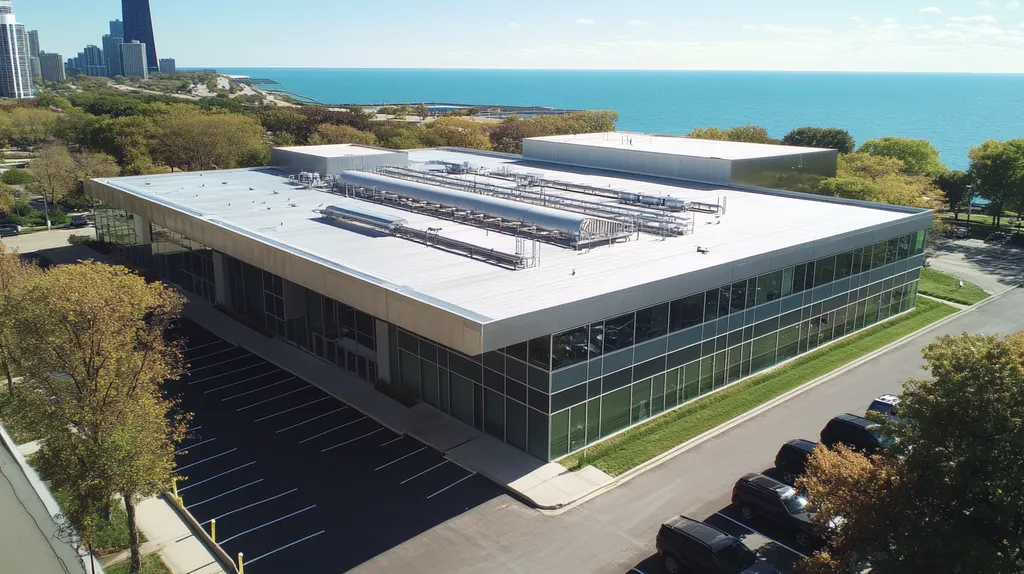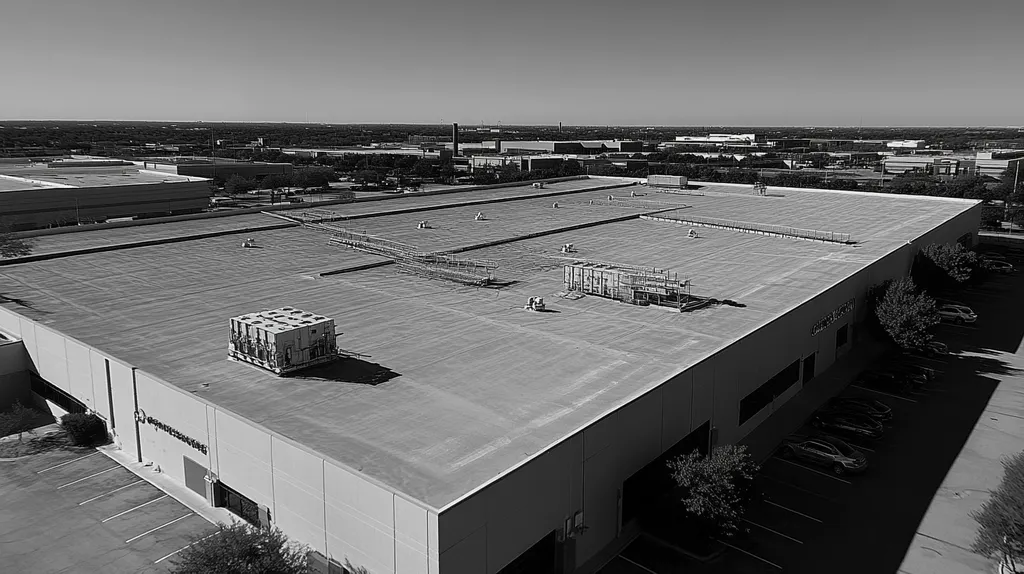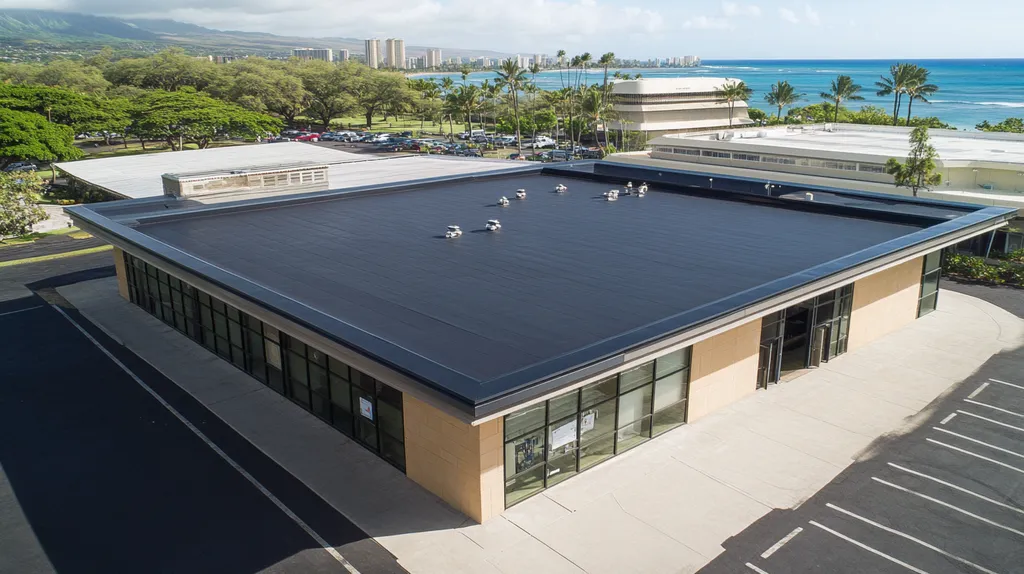Commercial and industrial roofs account for over 20% of urban heat absorption, making them a critical focal point in the battle against climate change. Yet studies show that less than 30% of eligible commercial roofs utilize protective coatings that could dramatically reduce their environmental impact.
Modern roof coating technologies offer facility managers powerful tools to enhance building performance while meeting increasingly strict environmental regulations. From solar-reflective formulations that slash cooling costs to low-VOC systems that protect air quality, today’s coating solutions deliver measurable sustainability improvements.
This comprehensive guide examines the fundamental concepts, implementation methods, and optimization strategies that enable commercial properties to maximize both protective performance and environmental benefits through strategic coating selection and application.
SECTION 1: FUNDAMENTAL CONCEPTS
Commercial and industrial roofing decisions have never carried more environmental weight than they do today. Every square foot of uncoated roofing surface contributes to rising urban temperatures, increased energy consumption, and accelerated climate impact. Modern roof coatings represent a critical intervention point, offering facility managers a practical way to enhance building performance while reducing environmental impact. This section examines the essential concepts behind roof coatings, their environmental implications, and the primary options available for commercial applications.
Understanding Roof Coatings Basics
Roof coatings function as a sacrificial barrier that protects the underlying roofing system from UV radiation, water infiltration, and thermal stress. These protective layers can be applied to most commercial roofing substrates, including modified bitumen, single-ply membranes, and metal roofing systems.
The effectiveness of a coating system depends heavily on proper surface preparation and application conditions. Temperature, humidity, and substrate cleanliness all play crucial roles in achieving optimal adhesion and performance.
Modern coating systems typically range from 20-40 mils in thickness when fully cured. This seemingly thin layer provides robust protection while adding minimal weight to the existing roof structure.
Quality coatings are engineered to maintain their protective properties through extreme temperature cycles, UV exposure, and regular precipitation. When properly maintained, these systems can extend roof life by 10-15 years.
Environmental Impact Considerations
Cool roofs represent a significant opportunity for environmental improvement in commercial buildings. ENERGY STAR labeled cool roof installations covering at least 75% of the roof surface, with a minimum initial solar reflectance of 0.65, can dramatically reduce cooling loads and urban heat island effects. (source: Washington Sustainable Schools Protocol)
Beyond energy savings, modern roof coatings help reduce landfill waste by extending the service life of existing roofing materials. This delay in roof replacement keeps thousands of tons of construction waste out of landfills annually.
Water quality benefits emerge from specialized coating formulations that reduce toxic runoff from aging roofing materials. This is particularly important in urban areas where stormwater management poses significant environmental challenges.
The manufacturing processes for current coating systems increasingly emphasize low-VOC formulations and sustainable production methods, further reducing their environmental footprint.
Common Coating Types Overview
Acrylic coatings dominate the commercial market due to their balance of performance and cost-effectiveness. These water-based systems offer excellent UV resistance and maintain flexibility throughout their service life.
Silicone coatings excel in areas with frequent rainfall or ponding water conditions. Their moisture-cured chemistry creates an exceptionally durable waterproof barrier that resists degradation from constant water exposure.
Polyurethane systems provide superior impact resistance and chemical stability. These characteristics make them ideal for roofs subject to high traffic or industrial exhaust exposure.
Advanced hybrid coatings combine the benefits of multiple chemistries. These engineered solutions can deliver enhanced performance characteristics while maintaining competitive installation costs.
Each coating type offers distinct advantages for specific applications, making proper selection crucial for long-term success. The choice depends on factors including climate conditions, roof substrate, and performance requirements.
SECTION 2: SYSTEM COMPONENTS
Commercial roof coating systems represent a critical investment in building performance and environmental responsibility. Studies show that up to 40% of energy loss in commercial buildings occurs through poorly protected roof surfaces. Understanding and selecting the right system components is essential for maximizing both protection and environmental benefits. This section examines the key elements that constitute an effective roof coating system.
Coating Materials and Properties
Modern coating materials offer diverse performance characteristics that directly impact environmental footprint. High-performance elastomeric coatings provide superior flexibility and UV resistance, while specialized reflective formulations dramatically reduce heat absorption.
Material density and coverage rates significantly influence both application efficiency and long-term performance. Thicker coatings generally provide better protection but require more raw materials and careful application techniques.
Install an ENERGY STAR labeled Cool Roof covering at least 75% of the roof surface, with a minimum initial solar reflectance of 0.65, to dramatically reduce cooling loads and urban heat island effects. (source: Washington Sustainable Schools Protocol)
Chemical composition plays a crucial role in environmental impact. Low-VOC formulations and bio-based components reduce harmful emissions while maintaining protective properties.
Adhesion and Compatibility Factors
Proper adhesion between coating layers and substrates determines system longevity. Poor adhesion leads to premature failure, requiring additional materials and increasing environmental waste.
Surface tension and chemical compatibility influence bonding strength. Different substrate materials require specific primer systems to ensure optimal coating adhesion.
Environmental conditions during application significantly impact adhesion quality. Temperature, humidity, and dew point must fall within acceptable ranges for proper curing.
Regular adhesion testing throughout the application process helps verify system integrity. Simple pull tests can identify potential issues before they lead to coating failure.
Roof Substrate Selection Criteria
Substrate condition and composition directly influence coating performance. Surface profile, porosity, and existing damage all affect how well protective coatings can perform their intended function.
Age and weathering of existing roof materials impact coating compatibility. Older substrates may require additional preparation or specialized primers to achieve proper adhesion.
Material expansion rates and structural movement must be considered. Mismatched thermal expansion between substrate and coating can lead to premature failure.
Local climate conditions influence substrate selection. Areas with extreme temperature swings or high UV exposure require more resilient base materials.
SECTION 3: IMPLEMENTATION METHODS
The implementation phase of commercial roof coating projects represents a critical inflection point where environmental benefits are either secured or squandered. Industry data shows that over 40% of coating failures stem from improper installation techniques, resulting in premature replacement and unnecessary environmental waste. Success demands meticulous attention to three key areas: surface preparation, coating application methodology, and rigorous safety protocols.
Surface Preparation Techniques
Surface preparation forms the foundation of any successful coating system. A thorough inspection must identify and document all existing damage, moisture infiltration, and structural concerns before work begins.
Power washing with appropriate pressure and cleaning solutions removes surface contaminants that can compromise coating adhesion. The cleaned surface requires adequate drying time to prevent moisture entrapment.
All seams, flashings, and penetrations need special attention during preparation. These high-stress areas often require reinforcement with compatible materials before coating application.
Environmental conditions during preparation significantly impact success. Surface temperature, ambient temperature, and relative humidity must fall within manufacturer-specified ranges.
Application Methods for Coatings
Coating application techniques directly influence both immediate performance and long-term durability. Different substrates and coating types require specific application methods to achieve optimal results.
Spray application offers superior coverage and efficiency for large areas but demands careful control of atomization pressure and tip size. Wind conditions must be monitored to prevent overspray issues.
Roller application provides excellent control for detail work and smaller projects. Proper roller nap selection ensures adequate coating transfer and uniform thickness.
Multiple thin coats typically outperform single thick applications. Each coat must achieve proper cure before subsequent layers are applied to prevent internal stresses.
Safety Protocols During Installation
Comprehensive safety protocols protect both workers and the environment during coating installation. Fall protection systems must be properly designed and maintained throughout the project.
Respiratory protection requirements vary based on coating chemistry and application method. Ventilation systems should maintain appropriate air exchange rates in confined areas.
Material handling procedures must address both worker safety and spill prevention. Secondary containment systems protect against environmental contamination from accidental releases.
Weather monitoring becomes a critical safety component. Lightning detection systems and wind speed monitors help determine when conditions become unsafe for continued work.
SECTION 4: MAINTENANCE REQUIREMENTS
Maintaining commercial roof coatings represents a critical intersection of environmental responsibility and asset protection. Studies show that poorly maintained coatings can deteriorate up to 70% faster than those under proper care protocols, leading to premature replacement and unnecessary environmental waste. Without systematic maintenance, even the most advanced coating systems will fail to deliver their promised environmental benefits and protective capabilities.
Routine Inspection Procedures
Systematic inspection protocols form the foundation of effective coating maintenance. These evaluations must occur at least quarterly, with additional checks following severe weather events or unusual environmental conditions.
Modern inspection techniques leverage digital imaging and infrared technology to detect problems before they become visible. These tools can identify moisture infiltration, adhesion loss, and coating degradation in their earliest stages.
Documentation requirements include detailed mapping of problem areas, photographic evidence, and trending analysis. This data enables facility managers to predict maintenance needs and optimize intervention timing.
Performance metrics must track both coating integrity and environmental impact factors. Key indicators include surface reflectivity, water resistance, and coating thickness measurements.
Repair and Restoration Techniques
Early intervention with appropriate repair techniques prevents cascading coating failures. Small breaches must be addressed within 48 hours of detection to prevent moisture infiltration and substrate damage.
Material selection for repairs demands strict compatibility verification. Using mismatched products can create weak points that accelerate system deterioration.
Application methods for repair areas must match original installation specifications. This includes proper surface preparation, environmental condition monitoring, and cure time verification.
Quality control testing of repaired areas ensures restoration of protective properties. Pull tests, moisture surveys, and adhesion checks validate repair effectiveness.
Preventative Measures Against Deterioration
Reducing environmental impact starts at the rooftop through proactive maintenance strategies. Regular cleaning protocols, drainage maintenance, and surface treatments extend coating life while minimizing waste and energy consumption. (source: Simon Roofing)
Traffic control systems protect vulnerable coating areas from mechanical damage. Designated walkways and equipment zones concentrate wear in reinforced sections.
Environmental monitoring systems alert facility managers to conditions that may impact coating performance. Temperature extremes, chemical exposure, and unusual weather patterns trigger protective responses.
Regular maintenance training ensures staff understand their role in coating protection. Clear protocols and response procedures maintain system integrity between professional service visits.
SECTION 5: PERFORMANCE METRICS
The environmental and financial impact of commercial roof coatings hinges on measurable performance metrics. Recent industry data shows that buildings with unmonitored roof coatings waste up to 40% more energy compared to those with documented performance tracking. Facility managers who implement comprehensive metrics programs consistently achieve better environmental outcomes while reducing operational costs by 15-30%. Understanding and tracking these key indicators enables data-driven decisions that maximize both protection and sustainability.
Energy Efficiency and Cost Savings
Surface temperature monitoring provides immediate feedback on coating effectiveness. Modern infrared scanning technology can detect variations as small as 2°F, enabling precise optimization of coating systems.
Energy consumption tracking reveals the real-world impact of coating choices. Buildings with properly monitored reflective coatings consistently demonstrate 20-35% reductions in cooling costs during peak summer months.
Cost analysis must account for both immediate and long-term savings. Initial coating investments typically pay for themselves within 3-5 years through reduced energy consumption and extended roof life.
Regular efficiency assessments help identify areas needing maintenance or recoating. Monthly energy use comparisons highlight seasonal variations and system degradation requiring attention.
Durability and Lifespan Evaluation
Coating thickness measurements provide critical data about wear patterns and remaining service life. Regular mil testing at consistent points creates trending data for predictive maintenance.
Adhesion testing reveals the ongoing bond strength between coating layers and substrates. Systematic pull tests identify potential failure points before visible damage occurs.
Weather resistance evaluation tracks coating performance through extreme conditions. UV exposure, thermal cycling, and moisture resistance testing predict long-term durability.
Impact resistance monitoring helps optimize traffic patterns and protection requirements. High-traffic areas often require additional reinforcement to maintain consistent performance.
Environmental Impact Assessment Tools
Sustainable commercial roofing minimizes environmental impact through careful material selection, waste reduction, and energy efficiency improvements. Proper assessment tools track these factors throughout the coating lifecycle. (source: Simon Roofing)
Carbon footprint calculations must include both manufacturing and operational impacts. Life-cycle analysis tools provide comprehensive environmental impact data for different coating options.
Waste reduction metrics track the environmental benefits of extended roof life. Every year of additional service prevents tons of roofing material from entering landfills.
Urban heat island contribution measurements assess broader environmental effects. Thermal imaging and surface temperature monitoring quantify a coating’s impact on local microclimate.
SECTION 6: OPTIMIZATION STRATEGIES
Commercial roof coating optimization has become a critical imperative as buildings face mounting environmental pressures. Studies indicate that unoptimized roof coatings can reduce energy efficiency by up to 40% while accelerating material degradation. Strategic optimization not only extends coating life but also maximizes environmental benefits through enhanced performance, reduced energy consumption, and sustainable practices. This section examines proven approaches that deliver measurable improvements in coating effectiveness and environmental impact.
Enhancing Coating Performance
Roof coatings have emerged as a key strategy for enhancing energy efficiency and mitigating the environmental effects of urbanization. Proper optimization requires systematic monitoring and adjustment of coating performance metrics throughout the service life. (source: Roof Coatings Manufacturers Association)
Surface preparation quality directly impacts coating longevity. Advanced cleaning protocols and substrate conditioning techniques ensure maximum adhesion and uniform coverage, reducing the risk of premature failure.
Application thickness monitoring through wet film gauges and regular mil testing helps maintain optimal material distribution. Consistent thickness prevents weak spots while avoiding excess material waste.
Regular performance evaluations using thermographic imaging and adhesion testing identify areas needing attention before visible deterioration occurs. This proactive approach prevents cascading failures that compromise environmental benefits.
Maximizing Energy Efficiency Gains
Strategic coating selection based on regional climate conditions maximizes energy reduction potential. Different formulations offer varying levels of solar reflectance and thermal emittance, requiring careful matching to local conditions.
Surface temperature monitoring through infrared scanning helps verify coating performance. Regular assessments track degradation patterns and identify opportunities for targeted maintenance or recoating.
Integration with building automation systems enables real-time performance tracking. Automated alerts highlight sudden changes in thermal patterns that may indicate coating issues.
Seasonal maintenance adjustments optimize coating effectiveness throughout the year. Modified cleaning schedules and inspection protocols account for changing environmental stresses.
Integrating Sustainable Practices
Material selection criteria must balance immediate performance needs with long-term environmental impact. Low-VOC formulations and recyclable components reduce the coating system’s environmental footprint.
Waste reduction strategies during application and maintenance minimize environmental impact. Precise quantity calculations and proper storage practices prevent material waste.
Staff training programs ensure consistent implementation of sustainable practices. Regular updates keep teams current on evolving environmental standards and optimization techniques.
Documentation systems track environmental performance metrics over time. Detailed records enable continuous improvement while validating sustainability claims.
The Bottom Line
With commercial roofs accounting for over 20% of urban heat absorption and energy waste, implementing effective coating solutions has never been more critical for environmental protection.
Modern coating technologies offer facility managers powerful tools to reduce their buildings’ carbon footprint while extending roof life by 10-15 years.
The data is clear: properties utilizing optimized coating systems consistently achieve 20-35% reductions in cooling costs while preventing tons of roofing material from entering landfills annually.
As environmental regulations tighten and energy costs rise, commercial properties that fail to implement strategic coating programs risk both compliance issues and significant financial impacts.
The time for proactive coating implementation is now – the environmental and economic costs of delay are simply too high to ignore.
FREQUENTLY ASKED QUESTIONS
Q. What are the basic concepts of coatings for a commercial roof?
A. Roof coatings act as protective barriers against UV rays, water, and thermal stress. They can be applied to various roofing materials and significantly enhance roof longevity and performance. Proper preparation and application are vital for achieving optimal adhesion and effectiveness.
Q. What are key components of an effective industrial roof coating system?
A. A successful roof coating system involves quality materials for durability, proper adhesion techniques, and compatible substrate preparation. Evaluating these components ensures long-term environmental benefits and optimal performance of the coating system.
Q. How should surface preparation for a commercial roof be done?
A. Proper surface preparation is crucial and includes thorough cleaning to remove debris and contaminants. All existing damages must be documented, and the cleaned surface should dry adequately to ensure good adhesion before applying the coating.
Q. What maintenance is required for commercial roof coatings?
A. Regular inspections and maintenance are essential to keep coatings performing well. These include quarterly checks and immediate attention to repairs. This proactive approach greatly extends the lifespan of roof coatings and their environmental benefits.
Q. How can performance metrics benefit a commercial roof?
A. Implementing performance metrics enables facility managers to track energy efficiency and coating effectiveness. This data helps identify areas needing maintenance, reduces overall costs, and enhances environmental outcomes by ensuring coatings perform as intended.
Q. What optimization strategies can enhance industrial roof coatings?
A. Effective optimization involves improving surface preparation, monitoring application thickness, and conducting regular performance tests. These strategies help maintain coating integrity and maximize energy efficiency, leading to extended service life and lower environmental impact.
Q. What are the benefits of a cool roof for commercial buildings?
A. Cool roofs reflect more sunlight and absorb less heat, significantly lowering building cooling costs. They also help mitigate the urban heat island effect, improving local climates and contributing to overall energy efficiency and sustainability in commercial properties.

